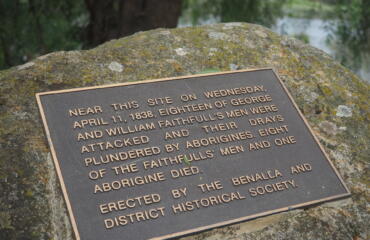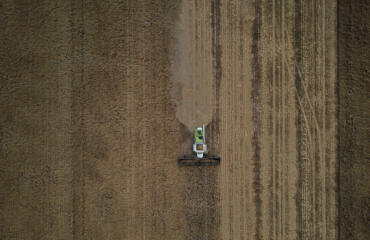A survey of Queensland teachers found that many were unaware of a 2008 directive by federal and state education ministers to incorporate sustainability across all subjects, while others said they did not have any spare room in a curriculum that they said was inflexible.
But schools in Victoria, NSW and ACT appear to be ahead in sustainability programs, where school yards are being turned into vegie patches and children are encouraged in water saving and other eco-friendly measures.
Victoria and NSW were part of a successful trial of the Australian Sustainable Schools Initiative (AuSSI), a federal government program implemented in 2005 in partnership with state and territory education and environment agencies. The scheme has since been axed.

Melbourne University senior lecturer in education policy Dr Glenn Savage says there is no way to ascertain whether sustainability – one of three Cross Curriculum Priorities (CCP) in the national curriculum – is being taught in all classrooms across Australia.
As a cross-curriculum priority, it must be incorporated within all subjects for students from years Prep to 10. (The other CCP issues are Aboriginal and Torres Strait Islander histories and cultures, and Asia and Australia’s engagement with Asia).
“But the question is, how aware are teachers about how to embed these priorities into their teaching?” says Dr Savage.
The president of the Australian Association of Environmental Education, Mark Caddey, says inconsistencies are emerging in sustainability education.
“Since the Commonwealth Government stepped away from AuSSI, support for a national approach on standards has slipped,” he says.
Both the federal Department of Education and the Australian Curriculum Assessment and Reporting Authority (ACARA) have put the onus of teaching sustainability onto the states.
“[The authority] identifies sustainability as a core component of curriculum, but draws a line where it will not mandate a pedagogy for implementation of sustainability education,” says Mr Caddey.
“And because the implementation of a CCP subject is left to the states, there is a lack of consistent policy on sustainability education, depriving teachers of education on integration of climate education in the curriculum.”
Research by Jennifer Nicholls at James Cook University revealed that primary and secondary school teachers in Queensland did not feel supported by curriculum materials that included climate change and sustainability. Consequently, many did not include the issue in their lesson plans, relying instead on incidental conversations and discussions with students.
“[S]upport for a national approach on standards has slipped . . . And because the implementation of a CCP subject is left to the states, there is a lack of consistent policy on sustainability education.” — Mark Caddey, president, Australian Association of Environmental Education
The survey of 300 teachers found that those who did tackle the issue did so through personal investigation and self-learning.
But Queensland’s Department of Education says its “Curriculum into the Classroom (C2C)”, which is a variant of the Australian curriculum, allows specific opportunities for sustainability education.
Dr Savage says that while variations of curriculum across Australia might allow flexibility for a state to adapt a subject such as sustainability to its own requirement, it makes implementation inconsistent.
“Are the states really using that flexibility to their advantage?” he asks.
Whether education on climate and sustainability extends beyond the classroom is often dependent on individual principals.
“Some schools have a broader commitment towards sustainability, more so than others,” says Dr Savage. “The whole school is geared around it. In most cases it is up to the principal’s interest.”
Victoria’s Banyule Primary school in Melbourne’s north-east is a standout, named school of the year by Resource Smart, an initiative of Sustainability Victoria, and one of more than 1000 schools in Victoria that have committed to putting sustainability front and centre of their programs.
Principal Sharon Marmo joined Banyule at a time when there were empty garden beds and little drive in the staff to be green.
“I felt that I had to do something for the environment,” she says. “I don’t want us to get to a day when there are no birds waking you up at five in the morning.”
The school’s effort is led by 10 teachers and 24 student leaders, who ensure every student participates and learns about sustainability. The school community comes together four times a year to participate in environment-friendly activities.

Rainwater tanks, solar panels, a greenhouse, a veggie patch, a chicken coop made from recycled bed frames, a gardening club and a wicking pot have made a “huge difference” in the children’s awareness, says Prep teacher Courtney Deacon.
She says that children from Prep to Year 6 willingly join the gardening club during lunch time to help water garden beds and feed the chooks.
Banyule Primary also won a Schools Water Efficiency Program award for demonstrating how to save water through efficient programming.
“We now know if our taps are leaking or we are not using rainwater efficiently,” says Ms Deacon.

Principal Marmo describes the enthusiasm displayed by students and parents as phenomenal. She was surprised to find three of her Grade 5 girls watering the garden beds during school holidays.
“The mums said that the girls had forced a small detour on the way to Phillip Island to water the veggie patch.”
Resource Smart’s Michael Birt says that it is not just about the money that the schools are putting into their programs.
“It could be a simple thing, such as having litter guards during lunch time,” he suggests. “This school has shown leadership specifically across biodiversity, water and energy savings, waste reduction, student and wider community engagement – this is no small task for a school of 579 students.”
The local community and city council have played a significant role in supporting Banyule Primary’s vision. Free seedlings, Bunnings gift vouchers, council demonstrations on clean energy, and excursions to the local recycling station have all been catalysts for inspiring students.
A school in Tasmania also put its small country town of Huonville on the map, winning $133,000 in an international competition by incorporating a range of sustainable solutions into school life, including retro-fitting a building to improve its energy rating from half-a-star to six stars.
But these success stories are sporadic. Dr Savage says there is a significant disparity in the way in which sustainability concepts are incorporated in the curriculum and teachers do not receive enough professional development to help them embed CCP subjects in their teaching.
“Some schools have a broader commitment towards sustainability, more so than others. The whole school is geared around it. In most cases it is up to the principal’s interest.” — Dr Glen Savage, Melbourne University senior lecturer in education policy
The Australian Sustainable Schools Initiative ended in 2011. Though there are multiple organisations offering resources on sustainability education, academics say that government is failing to provide adequate support at a national level.
The Australian Association of Environmental Education’s Mr Caddey says that Australia has a long road to travel to match the efforts of Scandinavian nations, Abu Dhabi and North America where sustainability education is far more explicit and places a strong and ongoing emphasis on nature education.
Hillary Whitehouse, the Deputy Dean of James Cook’s Graduate Research School, describes the situation as “disgraceful”, bemoaning the paucity of professional development opportunities for teachers.
“State governments and the national government are in complete denial about the need for systematic climate change education. It is not funded, and this absence is putting communities and populations at severe risk.”
Climate Council chief executive Amanda McKenzie says that when she goes out to schools to talk, most children seem to be aware of climate change and global warming.
“Young people just get the issue, that it needs to be addressed,” she says. “But what they ask is, what do we do about it, what next?”
Ms McKenzie, who is the co-founder of the Australian Youth Climate Coalition, says that more needs to be done to educate young people about how to make changes in the community.
“I think there is a piece missing, which is about civic duty. There isn’t enough knowledge on community engagement.”
A recent survey published by the journal Global Environment Change showed that one-in-five Australians do not believe in climate change, the highest percentage in the world of climate sceptics.



